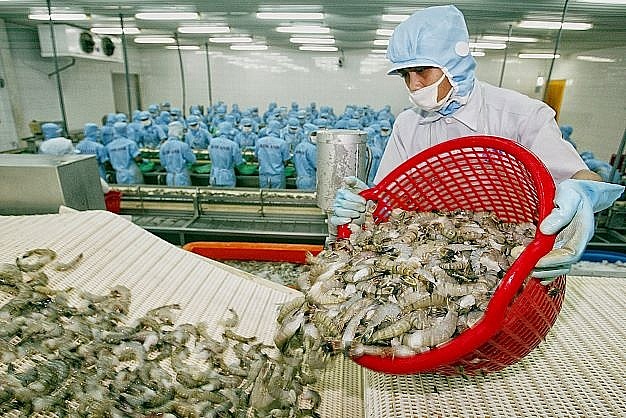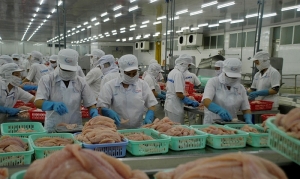Seafood sector striving to expand export market
Vietnam’s seafood exports reached a record $11 billion in 2022, up 24 per cent on-year and 22 per cent higher than the year's target of $9 billion. Besides traditional markets such as the US, Europe, and China, Vietnam’s seafood exporters have been entering other potential markets.
Notably, seafood exports to Australia grew impressively in 2022 with an increase of 42.64 per cent after 11 months compared to the same period in 2021, reaching a turnover of more than $331 million. In particular, the position of Vietnamese shrimp products in this market has been confirmed.
According to a representative of the Vietnam Association of Seafood Exporters and Producers (VASEP), as of December 2022, shrimp exports to Australia reached nearly $214 million, up an impressive 62 per cent over the same period in 2021.
The Philippines is another potential market for the seafood industry with more than 100 Vietnamese enterprises exporting seafood products there. Currently, the Philippines has risen to become the 13th largest single import market for Vietnamese seafood, up 10 places compared to 2020.
Truong Dinh Hoe, general secretary of VASEP said, “Currently, Vietnamese seafood has been exported to 160 markets around the world and it has a strong reputation. Seafood exporters are in a ready-to-supply position.”
However, Hoe also warned, "Seafood exporters need to regularly follow the market and capture information to adapt to the changing needs. It is necessary for Vietnam’s exporters to exchange information and expand their networks, ensuring they grasp the requirements and standards of any new markets and ensure product quality.”
In the long term, export enterprises need to build specific strategies and suitable solutions to adapt to harsh conditions and sudden changes in the market.
 |
Hoe pointed out three main areas where seafood exporters need to prepare well. The first is to maintain stable financial resources and allocate reasonable capital sources to operations. The second is to ensure jobs for employees and build human resources well. Thirdly, enterprises in the seafood sector need to pay attention to producers' livelihoods, because without them, there are no raw materials to sell.
Nguyen Xuan Thang, head of the Import-Export Management Department under Ho Chi Minh City Department of Industry and Trade, said that in order to expand exports, businesses need to continue to strengthen the available markets and diversify, especially eyeing those with free trade agreements. Enterprises also need to fully participate in the global value chain to improve their production and export capacity.
 | Infusing technology into labour export market Together with his team at job search platform HelloJob, CEO Nguyen Quoc Viet is not only resolving issues in the labour export market but also striving to build up an inspiring tech-empowered employment ecosystem, bringing numerous opportunities to labourers. |
 | Market tools help businesses export: experts Businesses should look more into using market research tools to identify foreign trade opportunities amid rising challenges, experts have said. |
 | Seafood sector expects rosier Q4 performance Albeit inflation still fetching high in some key export markets, seafood producers aspire to rosier business in the rest of the year, leveraging sound performance in the year to date and resumed demand at year-end period. |
 | Crucial certification needed to expand wood market The demand for FSC-certified wood is increasing, particularly from markets like the United States and Europe, forcing local wood processors to source more certified wood. However, this comes with a hefty price tag that increases the pressure on forest growers. |
 | Localities striving to build smart new-style rural areas Many localities are working hard to build smart rural areas, as part of a national target programme on building new-style rural areas. |
What the stars mean:
★ Poor ★ ★ Promising ★★★ Good ★★★★ Very good ★★★★★ Exceptional
Related Contents
Latest News
More News
- Businesses ramp up production as year-end orders surge (December 30, 2025 | 10:05)
- Vietjet chairwoman awarded Labour Hero title (December 29, 2025 | 13:06)
- How to unlock ESG value through green innovation (December 29, 2025 | 10:03)
- AI reshapes media and advertising industry (December 29, 2025 | 08:33)
- FPT and GELEX sign deal to develop blockchain tech for global markets (December 29, 2025 | 08:29)
- Vietnam’s GDP forecast to grow by 9 per cent in 2026 (December 29, 2025 | 08:29)
- Women entrepreneurs are key to Vietnam’s economic growth (December 29, 2025 | 08:00)
- Vietnam's top 500 value-creating enterprises announced (December 27, 2025 | 08:00)
- The PAN Group shaping a better future with ESG strategy (December 26, 2025 | 09:00)
- Masan Consumer officially lists on HSX, marking the next phase of value creation (December 25, 2025 | 13:20)

 Tag:
Tag:





















 Mobile Version
Mobile Version